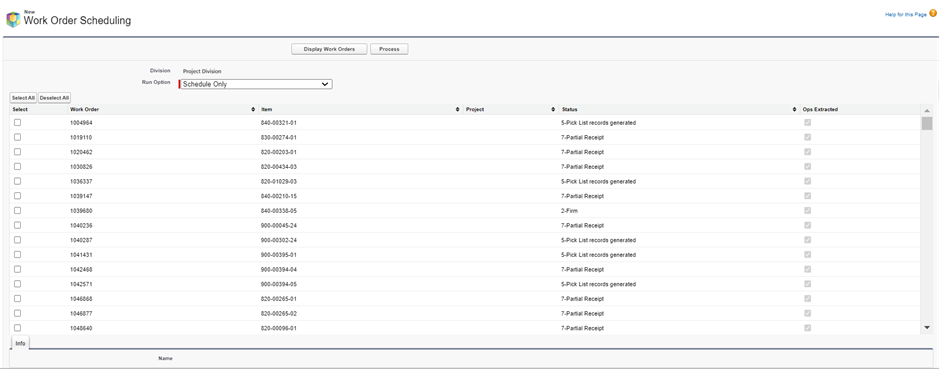Smart Work Capacity Planning & Scheduling in Rootstock
In the fast-paced world of manufacturing, efficiency and responsiveness are crucial for staying competitive. One of the keyways to achieve this is through effective scheduling and capacity planning. Leveraging the right tools can transform your operations, ensuring you meet customer demands while optimizing resource use. Rootstock ERP, a comprehensive cloud-based solution built on Salesforce, offers advanced capabilities for both scheduling and work center capacity planning. We'll explore how these features function in this blog and how they can significantly enhance your production operations.

Understanding Work Order Scheduling
Work order scheduling is the process of planning when each work order should start and complete. It’s a balancing act that involves aligning production processes with inventory levels, workforce availability, and equipment readiness. Effective scheduling ensures that manufacturing operations are streamlined, resources are utilized efficiently.
User can select from the below three options (run operations):
1. Schedule – Extract Operations if Necessary
This option displays all open Work Orders with at least a status of 2 (Firm). Users can select specific Work Orders to extract operations, set priorities, and generate the Dispatch Report.
2. Extracting only
This option shows only Work Orders which have not been extracted yet. Users can select these Work Orders to extract the necessary operations.
3. Scheduling only
This option lists all open Work Orders which are firmed. Users can choose Work Orders to prioritize operations and create the Dispatch Report without extracting new operations.
This flexibility allows for targeted scheduling based on specific project needs or operational priorities. The system supports both forward and backward scheduling methods, enabling adjustments based on due dates or lead times, and ensures that routing operations are extracted to create an effective dispatch list for each Work Center. As activities progress, any changes must prompt a re-run of the scheduling process to maintain accurate timelines and resource allocation.

The Role of Work Center Capacity Planning
Work center capacity planning is essential for managing the production capacity of individual work centers. A work center is a specific area in a manufacturing facility where tasks are performed, or machines are used. Each work center needs to be properly planned to ensure that production requirements are met without overloading resources.
Rootstock ERP offers robust tools for work center capacity planning, helping businesses manage and analyze work order schedules and work center capacities. Key features include:
- Graphical Display: The Capacity Planning Workbench provides a visual representation of operation requirements across work centers. This graphical display makes it easier to manage resources, identify scheduling conflicts, and resolve bottlenecks.
- Operational Flexibility: Users can adjust operation start dates, work centers, priorities, and due dates directly within the tool. This flexibility allows for quick adaptations to handle unexpected changes or resource constraints.
- Drag-and-Drop Functionality: This feature enables users to move operations within a work center or across different work centers. It’s particularly useful for reallocating resources or adjusting schedules to alleviate capacity issues.
- Color Coding: The Capacity Planning Workbench uses color codes to indicate the status of capacity and load. Green indicates no issues, yellow signifies reported activity, and red highlights capacity problems that need immediate resolution. This visual aid helps users stay informed about the status of their work centers and take timely action.
This system is built around Work Order operations, which define setup and run times that consume Work Center capacity. By utilizing various views such as:
· Overview,
· Work Orders
· Projects
Users can easily navigate their workload, view operation details, and make informed decisions to ensure on-time deliveries. The capacity planning tool also incorporates features for labor and machine hour tracking, ensuring that operations are balanced against available resources. Ultimately, the Capacity Planning Workbench empowers manufacturing teams to streamline operations, reduce lead times, and maintain optimal production flow.

How Rootstock ERP Enhances Business Efficiency
By integrating Rootstock ERP’s scheduling and work center capacity planning features, businesses can achieve several key improvements:
1. Enhanced Efficiency: Optimizing scheduling and capacity planning helps minimize downtime and improves the overall flow of production processes. By ensuring that work orders are scheduled correctly, and resources are used effectively, businesses can increase their production efficiency.
2. Increased Flexibility: The ability to adjust schedules and reallocate resources quickly allows businesses to adapt to changes in demand or unexpected disruptions.
3. Cost Management: Efficient scheduling and capacity planning contribute to better cost management. By ensuring that resources are used effectively and reducing unnecessary expenses, businesses can achieve significant cost savings and improve their bottom line.
Conclusion
Rootstock ERP provides a comprehensive solution for managing scheduling and work center capacities in manufacturing. Its advanced features for scheduling and capacity planning offer businesses the tools they need to enhance production efficiency, improve resource utilization, and manage operations effectively. By regularly utilizing these tools and adhering to best practices, companies can achieve a streamlined production process and maintain a competitive edge in the manufacturing industry. As a Rootstock partner, Blueflame Labs can help with setup by using our Salesforce and Rootstock specialists. For more insights into mastering manufacturing processes with Rootstock on Salesforce, stay tuned to our blog!
Recent Blogs

Cloud-Based ERP vs. On-Premises: Why Rootstock ERP Is the Future
Read More
NetSuite Fixed Asset Management: A Step-by-Step Guide
Read More
Personalized Experiences in Salesforce D2C Commerce vs. B2B Commerce
Read More
Overcome Manual Testing Challenges using Automation Testing Tool Provar
Read More
.NET MAUI: The Future of Cross-Platform Development
Read More
Salesforce and Shopify Integration
Read More
Unlocking the Power of Rootstock Cloud ERP for Wholesale Distributors
Read More
Advanced Billing in NetSuite: Introduction to Billing Schedules
Read More


 Strictly Necessary Cookies
Strictly Necessary Cookies